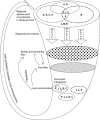Community assembly and coexistence in communities of arbuscular mycorrhizal fungi
- PMID: 27093046
- PMCID: PMC5030697
- DOI: 10.1038/ismej.2016.46
Community assembly and coexistence in communities of arbuscular mycorrhizal fungi
Abstract
Arbuscular mycorrhizal fungi are asexual, obligately symbiotic fungi with unique morphology and genomic structure, which occupy a dual niche, that is, the soil and the host root. Consequently, the direct adoption of models for community assembly developed for other organism groups is not evident. In this paper we adapted modern coexistence and assembly theory to arbuscular mycorrhizal fungi. We review research on the elements of community assembly and coexistence of arbuscular mycorrhizal fungi, highlighting recent studies using molecular methods. By addressing several points from the individual to the community level where the application of modern community ecology terms runs into problems when arbuscular mycorrhizal fungi are concerned, we aim to account for these special circumstances from a mycocentric point of view. We suggest that hierarchical spatial structure of arbuscular mycorrhizal fungal communities should be explicitly taken into account in future studies. The conceptual framework we develop here for arbuscular mycorrhizal fungi is also adaptable for other host-associated microbial communities.
Figures


Similar articles
-
Differential Responses of Arbuscular Mycorrhizal Fungal Communities to Long-Term Fertilization in the Wheat Rhizosphere and Root Endosphere.Appl Environ Microbiol. 2021 Aug 11;87(17):e0034921. doi: 10.1128/AEM.00349-21. Epub 2021 Aug 11. Appl Environ Microbiol. 2021. PMID: 34160265 Free PMC article.
-
Host identity impacts rhizosphere fungal communities associated with three alpine plant species.Microb Ecol. 2012 Apr;63(3):682-93. doi: 10.1007/s00248-011-9968-7. Epub 2011 Oct 27. Microb Ecol. 2012. PMID: 22038036
-
Mechanical soil disturbance as a determinant of arbuscular mycorrhizal fungal communities in semi-natural grassland.Mycorrhiza. 2011 Apr;21(3):211-20. doi: 10.1007/s00572-010-0325-3. Epub 2010 Jul 1. Mycorrhiza. 2011. PMID: 20593293
-
Mycorrhizas and soil structure.New Phytol. 2006;171(1):41-53. doi: 10.1111/j.1469-8137.2006.01750.x. New Phytol. 2006. PMID: 16771981 Review.
-
Arbuscular mycorrhizal fungi in national parks, nature reserves and protected areas worldwide: a strategic perspective for their in situ conservation.Mycorrhiza. 2012 Feb;22(2):81-97. doi: 10.1007/s00572-011-0419-6. Epub 2011 Nov 11. Mycorrhiza. 2012. PMID: 22075570 Review.
Cited by
-
Scale dependency of ectomycorrhizal fungal community assembly processes in Mediterranean mixed forests.Mycorrhiza. 2022 Jul;32(3-4):315-325. doi: 10.1007/s00572-022-01083-4. Epub 2022 Jun 4. Mycorrhiza. 2022. PMID: 35660964 Free PMC article.
-
Plant hosts may influence arbuscular mycorrhizal fungal community composition in mangrove estuaries.Mycorrhiza. 2021 Nov;31(6):699-711. doi: 10.1007/s00572-021-01049-y. Epub 2021 Sep 3. Mycorrhiza. 2021. PMID: 34477968
-
The Impact of Litter from Different Belowground Organs of Phragmites australis on Microbial-Mediated Soil Organic Carbon Accumulation in a Lacustrine Wetland.Microorganisms. 2025 May 16;13(5):1146. doi: 10.3390/microorganisms13051146. Microorganisms. 2025. PMID: 40431316 Free PMC article.
-
Within-Site Variations in Soil Physicochemical Properties Explained the Spatiality and Cohabitation of Arbuscular Mycorrhizal Fungi in the Roots of Cryptomeria Japonica.Microb Ecol. 2024 Nov 4;87(1):136. doi: 10.1007/s00248-024-02449-1. Microb Ecol. 2024. PMID: 39496952 Free PMC article.
-
Arbuscular mycorrhizal fungal communities with contrasting life-history traits influence host nutrient acquisition.Mycorrhiza. 2023 Mar;33(1-2):1-14. doi: 10.1007/s00572-022-01098-x. Epub 2023 Jan 3. Mycorrhiza. 2023. PMID: 36595061
References
-
- Bever JD, Richardson SC, Lawrence BM, Holmes J, Watson M. (2009). Preferential allocation to beneficial symbiont with spatial structure maintains mycorrhizal mutualism. Ecol Lett 12: 13–21. - PubMed
-
- Burrows RL, Pfleger FL. (2002). Arbuscular mycorrhizal fungi respond to increasing plant diversity. Can J Bot 80: 120–130.
-
- Camenzind T, Hempel S, Homeier J, Horn S, Velescu A, Wilcke W et al. (2014). Nitrogen and phosphorus additions impact arbuscular mycorrhizal abundance and molecular diversity in a tropical montane forest. Glob Change Biol 20: 3546–3659. - PubMed
-
- Cameron DD. (2010). Arbuscular mycorrhizal fungi as (agro)ecosystem engineers. Plant Soil 333: 1–5.
MeSH terms
LinkOut - more resources
Full Text Sources
Other Literature Sources
Medical

